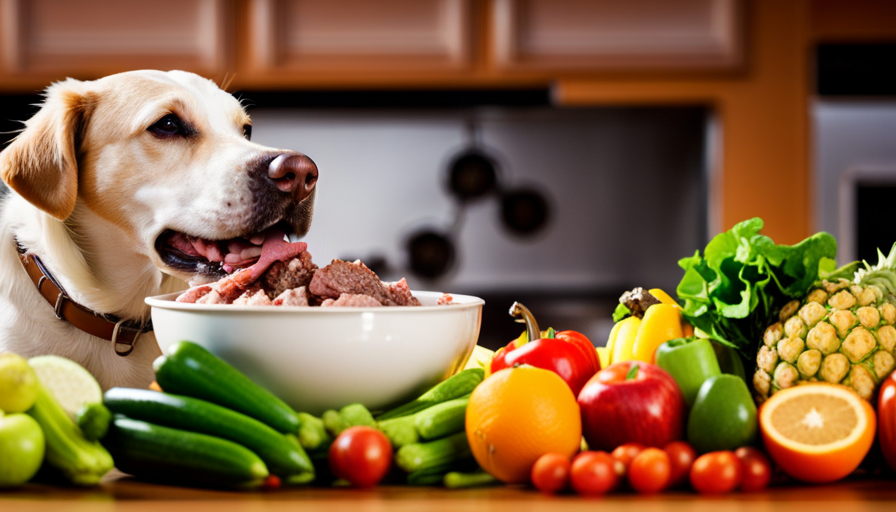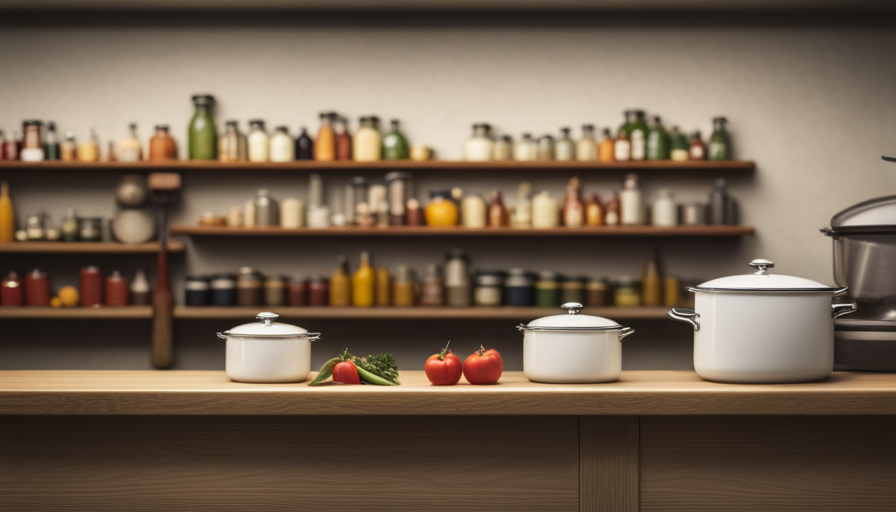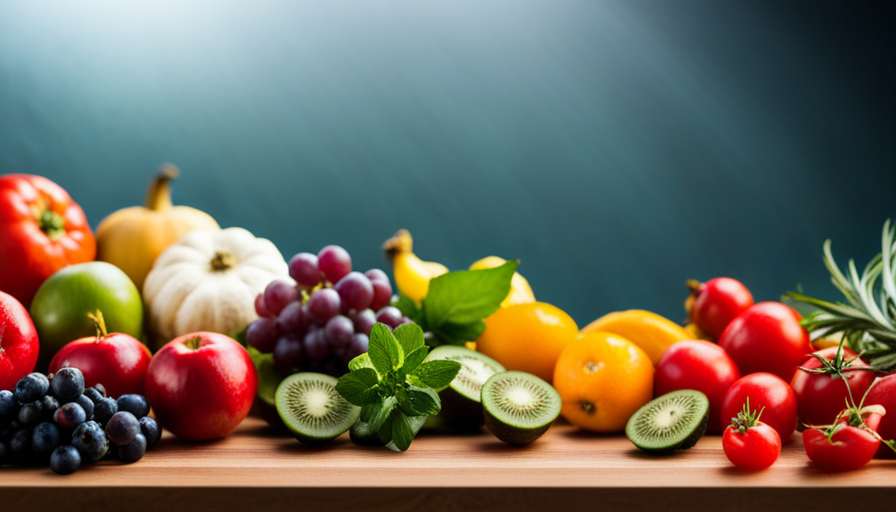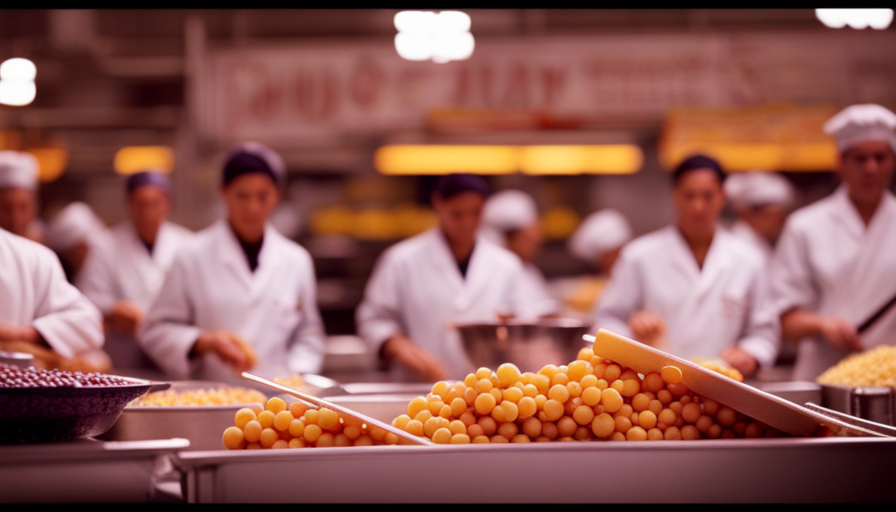Were you aware that more than 60% of dog owners are feeding their pets a raw food diet?
That’s right, more and more pet parents are embracing the idea of providing their furry friends with the same type of food their ancestors thrived on in the wild.
But is raw food safe for dogs? As a pet owner, I understand the importance of making informed decisions about my dog’s diet. That’s why I’ve delved into the research and consulted with experts to bring you this informative article.
In the following pages, we’ll explore the benefits of a raw food diet for dogs, as well as the potential risks and concerns. We’ll also discuss the nutritional requirements for dogs and provide guidance on how to transition your dog to a raw food diet.
So, let’s dive in and discover if raw food is the right choice for your furry companion!
Key Takeaways
- Raw food provides higher levels of nutrients compared to processed kibble.
- Raw food can contain harmful bacteria like Salmonella or E. coli.
- Homemade dog food may not always meet all nutritional needs.
- Proper handling and storage practices provide a safe and nutritious diet for dogs.
Benefits of a Raw Food Diet for Dogs
Feeding your furry friend a raw food diet will give them a healthier, more vibrant life. The benefits of a raw food diet for dogs are numerous and can greatly improve their overall well-being. One of the main advantages is that raw food provides dogs with a higher level of nutrients compared to processed kibble. This is because raw food contains natural enzymes and vitamins that may be lost during the cooking process.
These nutrients are essential for maintaining a strong immune system, promoting healthy digestion, and supporting optimal organ function. In addition, a raw food diet can help dogs maintain a healthy weight and reduce the risk of obesity. This is because raw food is generally lower in carbohydrates and higher in protein, which helps dogs feel fuller for longer.
Furthermore, some dog owners have reported that their pets have shinier coats, healthier skin, and fewer allergies after switching to a raw food diet. Overall, the benefits of a raw food diet for dogs are undeniable. However, it’s important to note that there are potential risks and concerns associated with this type of diet.
Potential Risks and Concerns of Raw Food for Dogs
When considering the potential risks and concerns of a canine’s diet, it’s crucial to evaluate the long-term implications of incorporating uncooked ingredients. While a raw food diet may have some benefits, it also comes with certain risks that pet owners should be aware of.
One of the main concerns is the potential for bacterial contamination. Raw food can contain harmful bacteria such as Salmonella or E. coli, which can cause serious illness in dogs and even be transmitted to humans.
Another risk is the imbalance of nutrients. Dogs require a specific balance of proteins, carbohydrates, and fats, as well as essential vitamins and minerals. Without proper planning and supplementation, a raw food diet may not provide all the necessary nutrients, leading to deficiencies or imbalances.
Additionally, bones in raw food can pose a choking hazard or cause dental issues.
It’s important to consult with a veterinarian before switching to a raw food diet to ensure the safety and nutritional adequacy for your dog.
Transitioning now to the subsequent section about ‘nutritional requirements for dogs’.
Nutritional Requirements for Dogs
Meeting the nutritional needs of our canine companions is crucial for their overall health and well-being. Dogs require a well-balanced diet that provides them with essential nutrients such as proteins, carbohydrates, fats, vitamins, and minerals. While there are various dog food brands available in the market that claim to meet these requirements, some owners prefer to prepare homemade dog food to have more control over the ingredients. However, it is important to note that homemade dog food may not always meet all the nutritional needs of dogs, as it can be challenging to achieve the right balance of nutrients.
To ensure that dogs receive the necessary nutrients, it is essential to understand their specific nutritional requirements. The following table illustrates the basic nutritional needs of an adult dog:
| Nutrient | Daily Requirement |
|---|---|
| Protein | 25-30% |
| Carbohydrates | 30-70% |
| Fats | 10-15% |
| Vitamins | Varies |
| Minerals | Varies |
Providing dogs with a balanced diet that fulfills these requirements can help support their overall health and prevent nutritional deficiencies or excesses. It is important to consult with a veterinarian or a veterinary nutritionist to ensure that the homemade dog food meets all the necessary nutritional needs.
Understanding the raw food diet for dogs can provide further insights into meeting their nutritional requirements and addressing any concerns regarding raw food safety.
Understanding the Raw Food Diet for Dogs
Discover the incredible benefits of a raw diet for your furry friend and watch them thrive! Switching your dog to a raw food diet can provide numerous advantages for their overall health and well-being. Here are four reasons why raw food is beneficial for dogs:
-
Improved digestion: Raw food contains natural enzymes that aid in digestion and nutrient absorption, leading to better overall gut health.
-
Enhanced energy levels: The nutrient-dense nature of raw food provides dogs with the energy they need to stay active and alert throughout the day.
-
Shinier coat and healthier skin: The high-quality proteins and essential fatty acids found in raw food contribute to a lustrous coat and prevent skin irritations.
-
Stronger immune system: Raw food is packed with vitamins, minerals, and antioxidants that boost the immune system and help fight off diseases.
In addition to benefiting dogs, a raw food diet can also be beneficial for cats. They have similar nutritional requirements and can thrive on raw food recipes specifically formulated for them. Transitioning your dog to a raw food diet is a gradual process that requires careful planning and consideration.
Transitioning Your Dog to a Raw Food Diet
To successfully transition your beloved furry friend to a raw food diet, you’ll need to gradually introduce new protein sources over a period of time, such as chicken, beef, or fish, ensuring they’re cooked thoroughly to avoid any potential risks.
For example, if your dog has been eating a commercial kibble diet, you can start by adding small amounts of cooked chicken to their meals and gradually increase the portion size over a few weeks, monitoring their reaction and overall well-being.
Transitioning to a raw food diet can be a significant change for your dog’s digestive system, so it’s important to proceed slowly and carefully. Introducing new proteins gradually allows your dog’s body to adjust and helps prevent any digestive upsets. Additionally, it allows you to monitor their response and ensure they’re tolerating the new diet well.
When introducing new proteins, it’s crucial to cook them thoroughly to eliminate any potential bacteria or parasites that could be harmful to your dog’s health. Proper cooking ensures that the proteins are safe and digestible. As you progress with the transition and your dog becomes accustomed to raw food, you can gradually reduce the cooking time until they’re consuming the proteins raw.
Transitioning your dog to a raw food diet requires patience and monitoring. By gradually introducing new proteins and ensuring they’re cooked thoroughly, you can help your furry friend adjust to their new diet while minimizing any potential risks.
Now, let’s delve into the subsequent section about the proper handling and preparation of raw food.
Proper Handling and Preparation of Raw Food
When handling and preparing the raw diet for your furry friend, make sure you wash your hands thoroughly and separate the different protein sources to avoid cross-contamination. Proper handling and preparation are crucial to ensure the safety of raw food for dogs.
One important aspect is proper storage. Raw food should be stored in the refrigerator or freezer to prevent bacterial growth. It’s essential to follow the storage guidelines provided by the raw food manufacturer to maintain its freshness and quality.
Another aspect to consider is the sourcing of raw food. It is vital to choose a reputable supplier that offers high-quality, human-grade ingredients. Look for raw food made from organic and ethically sourced ingredients to ensure your dog is getting the best nutrition. Additionally, some raw food options may include bones, so make sure they come from a trusted source to avoid any potential contamination or hazards.
By following proper handling and storage practices and sourcing raw food from reliable suppliers, you can provide your dog with a safe and nutritious diet.
In the next section, we will address common misconceptions about raw food for dogs, shedding light on important considerations for pet owners.
Common Misconceptions About Raw Food for Dogs
Despite the prevalence of myths surrounding raw diets, it’s important to debunk these misconceptions and provide accurate information for pet owners.
Many people believe that raw food is unsafe for dogs due to concerns about bacteria and nutrient imbalances. However, when handled and prepared properly, raw food can be a safe and nutritious option for dogs.
Firstly, there is a misconception that raw food is more likely to contain harmful bacteria such as Salmonella or E. coli. While it’s true that raw meat can carry these bacteria, proper handling and hygiene practices can greatly minimize the risk.
Secondly, some people believe that a raw diet can lead to nutrient imbalances. However, when properly formulated and balanced, raw diets can provide all the necessary nutrients for a dog’s health.
To further illustrate the safety of raw food, consider the following imagery: imagine a dog with a shiny coat, healthy teeth, and strong muscles, all thanks to a balanced raw diet. Picture a dog enjoying a variety of raw meats, bones, and organs that provide essential nutrients like protein, vitamins, and minerals. Envision a happy and energetic dog, thriving on a diet that closely resembles what their ancestors ate in the wild.
There are common misconceptions about raw food for dogs, but with proper handling and preparation, it can be a safe and nutritious option. However, before making any changes to your dog’s diet, consulting with your veterinarian is always recommended.
Consulting with Your Veterinarian
Consulting with your vet is the key to ensuring your furry friend’s diet is tailored to their specific needs. When it comes to alternative diets like raw food, it’s important to seek veterinarian advice before making any changes.
Your vet can provide valuable insight into whether a raw food diet is suitable for your dog and can guide you on the best way to transition them to this new diet. Veterinarians have extensive knowledge and experience in pet nutrition, and they can help address any concerns or questions you may have.
They can assess your dog’s current health status and determine if a raw food diet is appropriate for them. They can also take into account any specific dietary requirements or medical conditions your dog may have, ensuring that their nutritional needs are met.
Additionally, your vet can provide guidance on the proper balance of nutrients, vitamins, and minerals that your dog needs to thrive on a raw food diet. They can recommend specific foods or supplements that’ll help meet these requirements and ensure your dog remains healthy.
By consulting with your veterinarian, you can make informed decisions about your dog’s diet and provide them with the best possible care. With their expert advice, you can confidently embark on a raw food diet for your furry friend, knowing that their nutritional needs are being met. Transitioning to a raw food diet can be a positive step towards improving your dog’s overall health and well-being.
Monitoring Your Dog’s Health on a Raw Food Diet
After consulting with your veterinarian about transitioning your dog to a raw food diet, it’s important to closely monitor your dog’s health and progress on this new diet.
Monitoring your dog’s health involves observing their overall well-being, including their energy levels, coat condition, and stool quality. It’s also important to regularly weigh your dog to ensure that they’re maintaining a healthy weight.
As you begin feeding your dog a raw food diet, it’s normal for their body to undergo some adjustments. You may notice changes in their stool consistency, which can indicate if the diet is being properly digested. It’s also important to adjust the portions of food you’re feeding your dog, as their needs may change over time. Keep track of their progress and make any necessary adjustments to ensure they’re receiving the appropriate amount of nutrients.
Remember, every dog is unique, and what works for one may not work for another. It’s crucial to closely monitor your dog’s health and progress on a raw food diet to ensure their individual needs are met. Making an informed decision for your dog’s diet involves considering their health history, consulting with professionals, and closely monitoring their progress.
Making an Informed Decision for Your Dog’s Diet
When considering the best diet for your furry companion, it’s essential to gather all the necessary information and carefully assess their individual needs.
When comparing raw food versus kibble, it’s important to understand the potential benefits and risks associated with each option. Raw food diets for dogs have gained popularity in recent years, with proponents claiming that it mimics what dogs would eat in the wild and provides numerous health benefits. However, it’s crucial to note that the American Veterinary Medical Association (AVMA) and the American Animal Hospital Association (AAHA) do not endorse or recommend raw food diets due to the potential for bacterial contamination and the risk of nutritional imbalances.
If you are considering a raw food diet for your dog, it’s important to consult with a veterinarian who is knowledgeable about this type of feeding. They can provide guidance on creating balanced and complete meals that meet your dog’s nutritional requirements. It’s also essential to source high-quality ingredients and follow proper food handling practices to minimize the risk of bacterial contamination.
There are many raw food recipes available for dogs, which can include a variety of meats, vegetables, and supplements. However, it’s crucial to ensure that these recipes are nutritionally balanced and meet your dog’s specific needs. Consulting with a veterinary nutritionist can be beneficial in this regard.
Making an informed decision about your dog’s diet involves considering the potential benefits and risks of raw food versus kibble. Consulting with a veterinarian and following evidence-based guidelines can help ensure your dog’s nutritional needs are met while minimizing potential health risks.
Frequently Asked Questions
Can I feed my dog a raw food diet if they have a pre-existing health condition?
Yes, you can feed your dog a raw food diet even if they have a pre-existing health condition, such as allergies or digestive issues. A raw food diet for dogs with allergies can be beneficial because it eliminates common allergens found in processed dog food. Additionally, a raw food diet can help dogs with digestive issues by providing them with easily digestible and nutrient-rich foods. However, it’s important to consult with your veterinarian to ensure that the raw food diet meets your dog’s specific dietary needs.
What are some common signs that my dog may not be tolerating a raw food diet well?
Some common signs that my dog may not be tolerating a raw food diet well include vomiting, diarrhea, and gastrointestinal distress. These symptoms can indicate digestive issues and may suggest that the raw food diet isn’t agreeing with my dog’s system.
It’s important to monitor my dog’s health closely when transitioning to a raw food diet, and consult with a veterinarian if any signs of intolerance persist.
Is it necessary to include supplements in a raw food diet for dogs?
Including supplements in a raw food diet for dogs is necessary to ensure they’re getting all the necessary nutrients. While a raw food diet can provide many benefits, it may not always meet all of a dog’s nutritional needs. Supplements can help fill in any gaps and support their overall health.
This is particularly important for dogs with pre-existing health conditions, as their dietary requirements may be different. Consulting with a veterinarian can help determine the specific supplements needed for your dog’s raw food diet.
Can I mix raw food with kibble or other types of dog food?
Mixing raw food with kibble or other types of dog food can have both pros and cons. One advantage is that it allows for a gradual transition to a raw food diet, which can be beneficial for some dogs.
However, it’s important to consider that kibble and raw food have different digestion rates, which may cause digestive upset. Additionally, mixing the two may compromise the nutritional balance of the raw food.
It’s always best to consult with a veterinarian before making any dietary changes for your dog.
Are there any specific breeds or sizes of dogs that may not benefit from a raw food diet?
Specific breeds and sizes of dogs may not benefit from a raw food diet. For example, small toy breeds may struggle with the bone content in raw food, while large breeds may not receive enough calories from a raw diet.
Additionally, dogs with certain health conditions, such as pancreatitis or immune system disorders, may be at risk when consuming raw food. It’s important to consult with a veterinarian before making any dietary changes for your dog.
Is Freeze-Dried Raw Pet Food Safe for Dogs?
Freezedried raw pet food cans offer a convenient, nutrient-rich option for canine companions, mimicking their ancestral diet. Despite concerns, when sourced responsibly and prepared safely, these products can provide a balanced diet for dogs, assuming pets have no pre-existing health issues requiring specific nutrition.
Conclusion
After weighing the benefits and risks of a raw food diet for dogs, it’s clear that there are potential advantages. Improved digestion and healthier skin and coat are some of the benefits. However, it’s important to note that this diet also comes with potential risks. Bacterial contamination and nutrient imbalances are among the risks. Therefore, it’s crucial to consult with a veterinarian before making any dietary changes for your dog. Remember, knowledge is power, and by staying informed and making evidence-based decisions, you can ensure the best possible health for your furry friend.
As the saying goes, "An ounce of prevention is worth a pound of cure."










